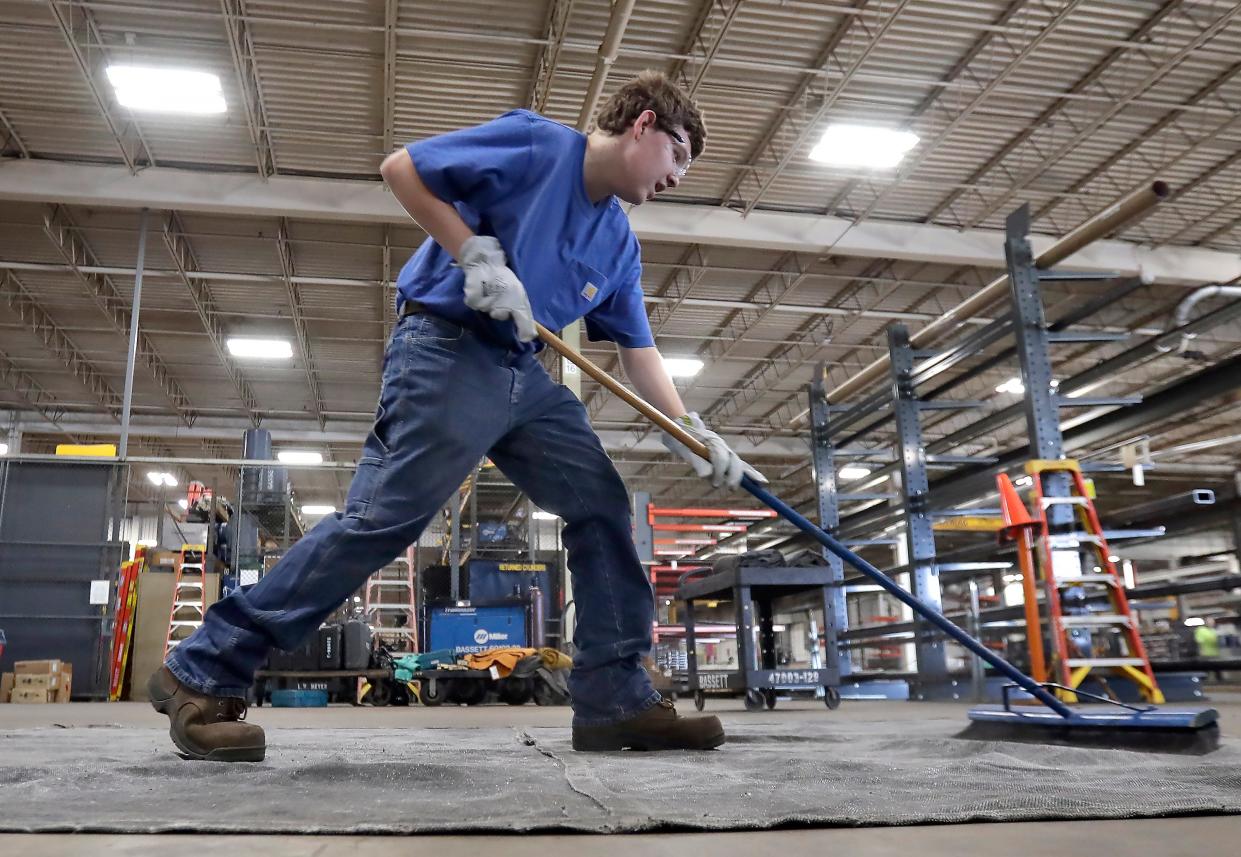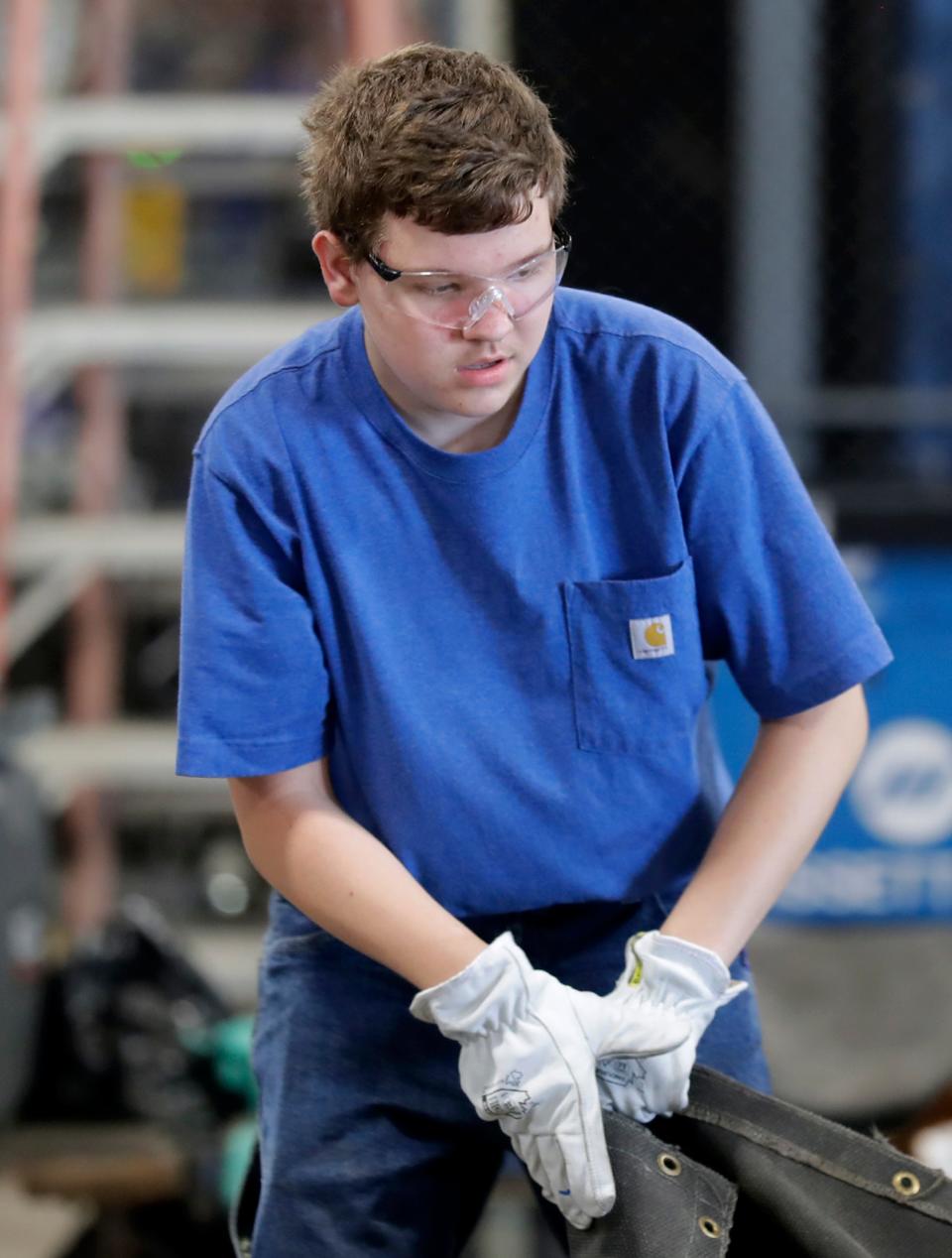Want to try a career before leaving high school? In this program, kids earn credit in paying jobs

This summer, 16-year-old Carter Steward's day begins at 8:30 a.m. sorting through an array of mechanical tools.
The Appleton East High School student didn't know he could work as a paid youth apprentice — a job that sets him on track for the career he wants in welding — until a teacher suggested it.
"You can only really know about it if you take a shop class, or something related to that," Steward said. "Normal classes won't give you that option."
He’s among the increasing pool of students in Wisconsin who are getting paid to work at least 450 hours for a local employer as part of their high school education.
Designed to introduce young people to industries before they leave high school, the state's youth apprenticeship program reached a record last year at 8,359 students. That's almost four times the number of participants compared with a decade ago.
Worker shortages have drawn attention across Wisconsin, especially after the pandemic. Proponents of the youth apprenticeship program say it's a win-win solution: it allows employers to build and train their future workforce, while giving students a chance to test-run potential careers before committing.
But there are limitations. While some districts send close to half their eligible students through the program yearly, others — including Milwaukee Public Schools, the largest K-12 district in the state — send relatively few.
And researchers who studied the program say it could better connect high school apprentices with job-training programs after graduation.
Closing those gaps will take investment.
The state budget approved in July reserves $19 million for local youth apprenticeship grants — a sizable increase for a fund that, in the previous state budget, capped at $12 million. That money is split in chunks of up to $1,100 per student and doled out to the local "consortia" that operate youth apprenticeships in different regions of Wisconsin.
“It’s amazing that Wisconsin has been able to do as much as it has with a very, very small allocation, from my perspective,” said Robert Lerman, a national researcher who studies apprenticeships. “I think that some additional investments would also yield big benefits. I think it's one of the most cost-effective programs that you'll see.”
More: How Wisconsin youth apprenticeships work, and what's available
Wisconsin expanding apprenticeships beyond traditional trades
Wisconsin’s youth apprenticeship program is the oldest and largest of its kind in the United States, according to an Urban Institute policy brief released in July. It has grown substantially since its first school year in 1992-93 when just 21 students participated.
Statewide, 5,743 employers took on high school students as apprentices in 2022-23.
About two in five students, or 43%, worked in areas typically associated with the trades last year: agriculture, food and natural resources, architecture and construction or manufacturing.
As the program has expanded, so have job options. Another 17% of last year's youth apprentices worked in health sciences, the second largest "program area" after manufacturing.
Added last summer are arborist, dairy grazier, phlebotomist and IT broadband technician apprenticeships, among others. In fall 2024, apprenticeships will open up in education and training; business management and administration; government and public administration; human services; law, public safety, corrections and security.
No matter their job, students are required to devote 450 hours at the job site per year of their apprenticeship, up to two years. It averages out to about 10 to 15 hours weekly. Also required are two semesters per year of "related coursework."
Steward is getting started early: the summer before junior year. He knows it’s an investment, but he’s happy about it.
“It keeps me out of the house,” he said with a laugh.
The 'bridge' to registered apprenticeships is small, but growing

As part of his youth apprenticeship at Bassett Mechanical, Steward will “shadow” professional pipefitters, sheet metal workers and HVAC technicians. The steady, competitive salaries typically associated with those job titles all require a "registered" apprenticeship — up to a six-year commitment and a minimum 2,000 hours of training, depending on the specialty.
Exposure to various careers within the trades is essential at this point in Steward's career, says Bassett’s Chief HR Officer Patty Van Ryzin, “so he can feel good about the next five years, because that’s serious business with the (registered) apprenticeship.”
Tania Kilpatrick is the regional coordinator for the largest youth apprenticeship consortium in Wisconsin, known as CESA6. The program usually leads to one of two outcomes, she said: Students might realize the career they apprenticed in is right for them. Or, the exact opposite.
Both experiences are valuable.
"If you're going to go to school to be a (veterinarian) someday, let's say," Kilpatrick said, "you should probably have this type of experience before you go and spend eight years in school and a lot of money."
If Steward decides that's the right path for him, he has a good chance of moving forward: the company hires about 90% of its youth apprentices, Van Ryzin said.
But the youth program does not guarantee students a registered apprenticeship. Instead, it leads to a "certificate of occupational proficiency," and in some cases, college credit. Its resume-builders like industry knowledge, hard skills and connections to employers that are often cited as its main benefits.
More than 200 youth apprentices "bridged over" to a registered apprenticeship in the most recent year, said David Polk, director of the Bureau of Apprenticeship Standards, in an interview.
That's a record for the department and an increase from 125 the year prior, but still small considering the thousands of youth apprentices statewide.
There are some connections between youth and registered apprenticeship programs already, but Polk said the department wants to increase the number of students who bridge between them.
The Urban Institute researchers described the youth program as operating "almost completely outside" the system for registered apprenticeships. Lerman, the study's co-author, Wisconsin could do more to integrate the programs.
"That would require an additional investment, but I think it would be very worthwhile,” he said in an interview.
Apprenticeships concentrated in industry-heavy regions of Wisconsin
Although youth apprenticeship is increasing overall statewide, participation is scattered. Districts decide whether to designate a staff member to oversee the program and build it up over time, if at all.
Of the 39 "consortia" overseeing youth apprenticeship in local regions of the state, two far outstrip their peers in terms of student participation. CESA6, which covers the Appleton, Oshkosh and Fond Du Lac areas, oversaw 1,779 students last school year. The consortium in Northeast Wisconsin managed another 1,021. The other 37 consortia average 151 students each.
One room for growth is within the state's largest school district. Of the 8,013 juniors and seniors in Milwaukee schools last year, 86 — 1% — worked as youth apprentices.
The district had a close to three-year hiatus without an apprenticeship coordinator, Polk said, but recently filled the position. He said increasing participation in Milwaukee is a goal for the department.
In contrast, 44% of juniors and seniors in the small, rural Valders Area School District apprenticed last school year — among the highest participation rate statewide. The program has grown from 10 students in 2016-17 to 62 last year.
Valders High School Principal David Schmid attributes the high numbers largely to location: the district is located in manufacturing-heavy Manitowoc County. Worker shortages caused by the pandemic caused a bump in the numbers.
“The opportunities to get a good paying job without having to go to college are pretty abundant in our area,” he said.
Some students "are going to work with their hands when they leave high school," Schmid said, and it might not make sense to force them into an eight-period school day. Many youth apprentices leave school early to work at their job site.
Valders has help placing students with employers from its local consortium: CESA6. Within the educational service agency's department focused on college and careers, approximately 16 of 20 staff specifically focus on youth apprenticeship. It’s CESA6 that receives up to $1,100 reimbursements per apprentice from the state, not local schools.
That funding is directed to several different areas, Kilpatrick said, like staffing, marketing, technology and mileage. The organization also helps schools pay the dual enrollment costs that arise when students' "related coursework” requires them to take classes outside their high school.
Those dual enrollment costs can "cause schools to limit or become less than enthusiastic about scaling apprenticeships," according to the Urban Institute brief. In an interview, Lerman said the $1,100 reimbursements are not enough when considering dual enrollment costs.
One pool of money districts can pull from is the "career and technical education incentive grant” program, which pays up to $1,000 for every student who earns certain industry-specific certifications. That funding stream will increase to $16 million in the 2023-25 state budget, up from $13 million.
State Sen. André Jacque, R-De Pere, introduced a bill in May that would have increased the $1,100 payments to $1,700, and $1,000 to $2,000, among other changes. Although it did not move forward specifically, he is encouraged by the increased program funding.
“The more we have, the more we can do. It’s important to have resources to grow the program because it’s definitely an area that more people are moving (to),” Jacque said. “This is just a huge resume builder for students.”
This article originally appeared on Milwaukee Journal Sentinel: Wisconsin youth apprenticeship programs sees record student growth

